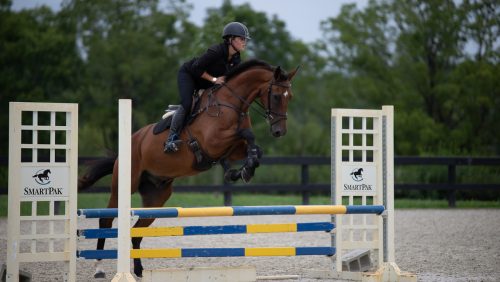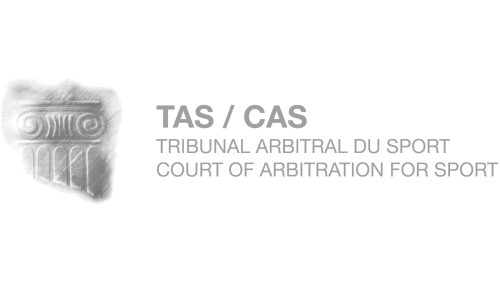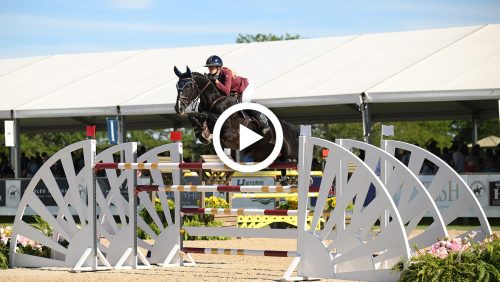Westerville, Ohio—Nov. 13
On Day 1 of the Emerging Athletes Program National Training Session, the 16 finalists received their assigned mounts for the weekend at Otterbein University (Ohio). Each rider was able to hack around to get a feel for what they were working with, but today it was all about starting with the basics for lead clinician Peter Wylde, who put each group through their paces with numerous trot transitions and trot-to-canter work.
“These transitions, if done well, are what really put your horses together,” explained Wylde. “They start to collect your horses and bring them together. We’re going to establish your connection with your horse now, so that [the courses they’ll jump on] Sunday is better.”
After flatwork each session started off jumping a small crossrail on a circle, then moved on to navigating a bending line bounce combination, which Wylde used to show riders how to collect and lengthen. At the end each group transitioned to riding a five-stride line both directions to bring the horses back to a normal canter.
Wylde stressed to riders the importance of showing their mounts when they were performing correctly through the exercises.
“Remember there are times when your horses are quiet and relaxed, so that you can melt over the top of the jump,” he said. “There are times where you have to resist and times where you have to relax, and you have to think about that.”
When Cary Hundley’s horse Shane was particularly quiet through the bounce, Wylde was quick to remind her to reward her mount.
“When they’re good, that’s when you melt; that’s their reward,” he said.
“That’s part of today—to teach these horses to be polite, to wait,” he continued. “We’re teaching them to be polite—it’s hard, but this is how you educate the horse.”
When Ramsome Rombauer kept finding long distances into the first bending line then trying to collect for five strides to the bounce, Wylde pointed out that sometimes the first distance isn’t always right.
“As hunter/jumper riders, we’re so trained to take the first one we see out of the turn,” Wylde said. “And you have to resist that temptation and make yourself wait.”
ADVERTISEMENT
Wylde also encouraged the riders to think actively about their rides and equipment. Toward the end of each session, he asked for their input on bit types and spurs, taking their ideas seriously. Tomorrow the finalists will have the opportunity to work with their assigned mounts again and prepare for a Nations Cup-style competition on Sunday to show how much they have improved.
“We had a good group today,” said Wylde. “I’m looking forward to Sunday.” Wylde is no stranger to the EAP Nationals. The 2004 Olympic U.S. team gold medalist has been the lead clinician since the program started n 2009. And each year he has imparted his knowledge of the sport to eager students who have come to learn.
The EAP Nationals brought together 16 finalists from all over the country—chosen from several regional qualifying clinics—to take part in a comprehensive training and horsemanship program. This is the first year Otterbein University was selected to host the EAP Nationals.
Over the course of this weekend, these 16 riders are divided into groups of four that rotate throughout the day through four activities. Each student will ride with Wylde, serve as jump crew for another group and learn about equine physiotherapy from Janus Marquis, who serves as the physiotherapist for the U.S. show jumping team. They are also assigned a horse to ride, feed, groom and care for during the training program with the assistance of Anne Thornberry. These lessons are designed to provide each rider with a well-rounded education in horsemanship.
This year a panel consisting of Wylde, Marquis, Thornberry, the Emerging Athletes Program Committee Chair Sally Ike, and USHJA Vice President Mary Babick talked about teamwork and the importance of hard work and then opened it to questions from the riders. This took the place of equine sports psychologist Kip Rosenthal, who was unable to make the clinic this year due to an illness.
The EAP Nationals are also held with the USHJA Horsemanship Quiz Challenge, a multi-phase test that has brought together the 14 highest scoring participants to take the ultimate test. They will have to complete a written exam, horsemanship/identification, and a final practicum to demonstrate their depth of knowledge. At the end of the weekend team and individual winners will be announced alongside the EAP Awards.
Emerging Athletes Program Finalists:
Ashley Scott Armstrong, age 16, Atlanta, Ga.
Abigail Brayman, age 16, Charlestown, R.I.
Rachael Davis, age 16, Woodinville, Wash.
Kendra Duggleby, age 15, Cleveland, N.Y.
ADVERTISEMENT
Eliza Gretok, age 18, Woodward, Pa.
Mackenzie Haskell, age 19, Fair Haven, N.J.
Cary Hundley, age 19, Ellicott City, Md.
Caroline Johnson, age 19, Grafton, Mass.
Quinn Larimer, age 19, Atlanta, Ga.
Abigail Lowin, age 18, Red Hook, N.Y.
Rosie Powers, age 19, Middleburg, Va.
Ransome Rombauer, age 16, St. Helena, Calif.
Danielle Roskens, age 19, South Lyon, Mich.
Megan Spitzer, age 17, Peoria, Ill.
Adelaide Toensing, age 15, Charlotte, Vt.
Michael Williamson, age 15, Loomis, Calif.














